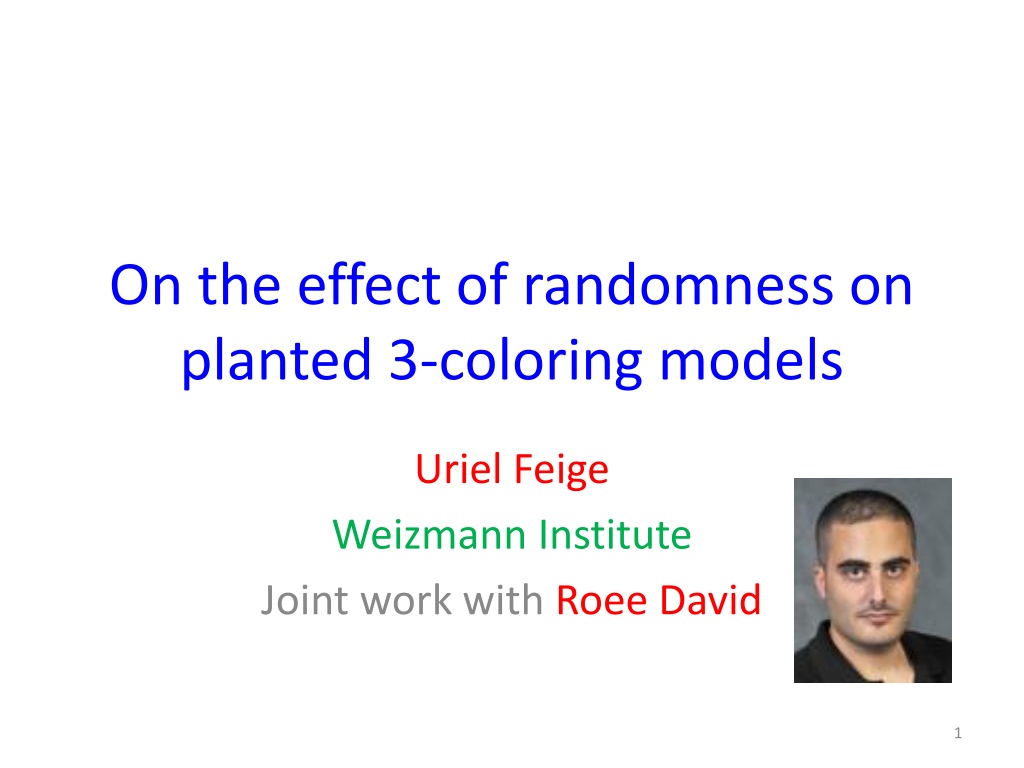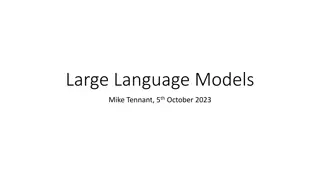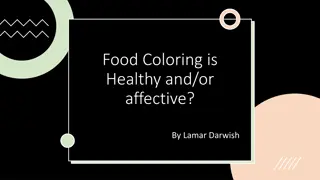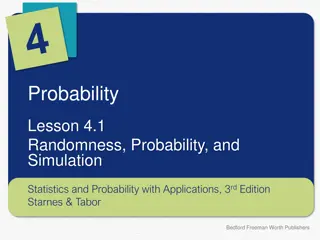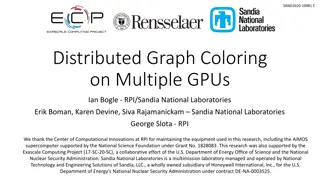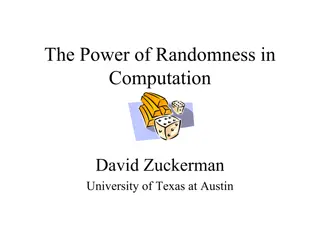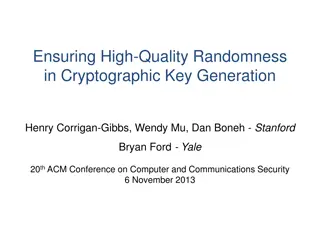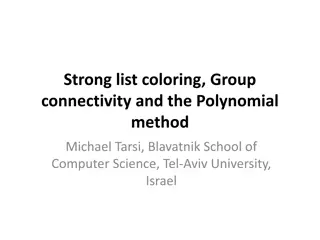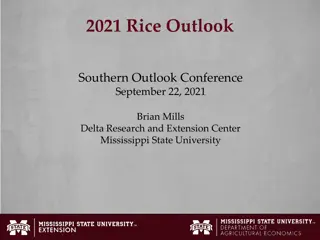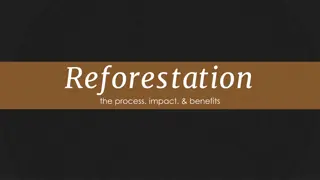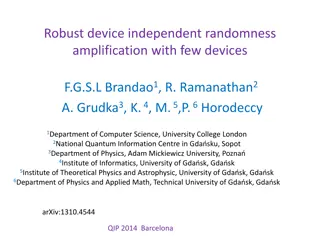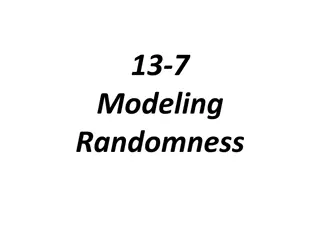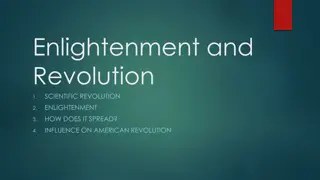Exploring the Impact of Randomness on Planted 3-Coloring Models
In this study by Uriel Feige and Roee David from the Weizmann Institute, the effect of randomness on planted 3-coloring models is investigated. The research delves into the NP-hard nature of 3-coloring problems, introducing a hosted coloring framework that involves choices like the host graph and the planted coloring. The algorithmic challenge is to legally 3-color a graph, with varying levels of difficulty depending on the selection of the host graph and planted coloring. The random planted 3-coloring model involves randomness in both the host graph and the planted 3-coloring.
Uploaded on Sep 06, 2024 | 0 Views
Download Presentation

Please find below an Image/Link to download the presentation.
The content on the website is provided AS IS for your information and personal use only. It may not be sold, licensed, or shared on other websites without obtaining consent from the author. Download presentation by click this link. If you encounter any issues during the download, it is possible that the publisher has removed the file from their server.
E N D
Presentation Transcript
On the effect of randomness on planted 3-coloring models Uriel Feige Weizmann Institute Joint work with Roee David 1
NP-hard problems 3-coloring is NP-hard: for every polynomial time 3-coloring algorithm, there are (worst case) 3-colorable graphs on which it fails. We consider a framework that attempts to draw the line between easy and hard instances. Similar frameworks apply to other NP-hard problems. 4
Hosted coloring framework Involves two choices: A host graph H. A planted (not necessarily legal) coloring P. The input graph G is obtained by removing from H those edges monochromatic under P. 5
The algorithmic challenge The input is the graph G. (The algorithm never sees H or P.) The goal is to legally 3-color G in polynomial time. G may have several legal 3-colorings. There is no requirement to recover the planted 3-coloring P. 11
Different models within the framework Depending on how the host graph H and/or the planted coloring P are selected, the 3-coloring algorithmic challenge might be easy or hard. Example: if both H and P are selected arbitrarily by an adversary, 3-coloring is NP-hard. 12
The random planted 3-coloring model Host graph H is random ??,?. Planted 3-coloring P is random. Same as the ??,?,? model of random k-colorable graphs introduced by Kucera [1977]. We use the notation ??,? where ? = ?(? 1) is the expected average degree. Our random version can be denoted as ??,?,3. 13
Alon and Kahale [1997] Theorem 1: A spectral algorithm finds the planted 3-coloring P whenever ? > ?log?. Theorem 2: Even at smaller values of ?, a regime in which P is no longer the unique 3-coloring, a polynomial time algorithm can find a legal 3-coloring, provided that ? > ?. All results hold almost surely, for random choice of G and P. 14
Our questions Which aspects of randomness are needed for the Alon-Kahale result? Which aspects of randomness are needed for the host graph H? Does expansion suffice? Does the planted coloring P need to be random? Can we instead allow an adversary to choose it after seeing H? 15
Outline of talk Review the algorithm of Alon and Kahale, and sketch its analysis. Consider what changes when the host graph is an expander chosen by an adversary. Consider what changes when the planted coloring is adversarial. Open questions. 16
Notions of coloring P the planted coloring. B-approximate coloring: not necessarily legal, and at most B vertices colored differently than in P. Safe B-partial coloring: all but at most B vertices colored as in P, and the remaining vertices are not colored (free). Legal coloring not necessarily P. 17
Good and bad vertices A (roughly) d-regular host graph, a planted 3-coloring P. Good vertex: roughly d/3 neighbors of each color class. Lemma: if P is random, then number of bad vertices is B 2 (?). ? 18
Steps of Alon-Kahale algorithm ? ?-approximate Spectral clustering. (? coloring.) Local improvement. (? ? -approximate coloring.) Cautious uncoloring. (Safe ? ? -partial coloring.) Dynamic programming. (Legal coloring.) 19
Spectral clustering Let ?1 ?2 ?? be the eigenvalues of the adjacency matrix* of ?. Compute the eigenvectors corresponding to ?? , ?? 1. Gives an embedding (??(?) , ?? 1(?)) of the vertex ?? on the plane. Cluster into three (illegal) color classes based on distance. ? ?-approximate coloring. Theorem: this gives an ? 20
? ?-approximate coloring (Green codes for agreeing with planted) An ? 21
Local improvement Local improvement: move a vertex v from its current color class into a color class in which v has fewer neighbors. Perform local improvement steps (in parallel) until no longer possible. Theorem: this gives an ? ? -approximate coloring. ? Recall: number of bad vertices is B 2 (?). 22
? ?-approximate coloring An ? 23
Cautious uncoloring A colored vertex is suspect in a partial coloring if it has fewer than d/6 neighbors in one of the other color classes. Iteratively, uncolor suspect vertices, making them free. Theorem: this results in a safe? ? -partial coloring. 25
Dynamic programming Given the safe partial coloring, it remains to color only the free vertices. ? The number of free vertices is O(B) vertices were random, they would almost surely decompose into small connected components. 2 (?). If the free Theorem: w.h.p., there is no connected component of free vertices of size larger than ?(?????). Extend the partial coloring to each component separately by exhaustive search. 28
Summary of Alon-Kahale algorithm ? ?-approximate Spectral clustering. (? coloring.) Local improvement. (? ? -approximate coloring.) Cautious uncoloring. (Safe ? ? -partial coloring.) Dynamic programming. (Legal coloring.) 31
Does the host graph need to be random? The first step (spectral clustering) hinges on ??? ? The analysis of other steps (local improvement) uses expansion of H. This is captured by requiring ?2? ?. Let ? = min[?2? ,|??? |]. Suppose that an adversary is allowed to pick H arbitrarily with ? < 30 (spectral expander), and P is random. Can one still 3-color such graphs? 3 (equivalently, |??? | ? 3). ? 32
Algorithm for 3-coloring with spectral expander host graph ? ?-approximate Spectral clustering. (? coloring.) Local improvement. (? ? -approximate coloring.) Cautious uncoloring. (Safe ? ? -partial coloring.) Dynamic programming. (Legal coloring.) 33
Our algorithm for spectral expander host graph follows the same steps as the algorithm of Alon and Kahale. Some of the details of how the steps are implemented differ. Differences in the analysis it has to work with only relatively mild expansion, and no randomness assumptions on the host graph H. 34
Perhaps the most complicated proof in [Alon and Kahale 1997] Thm: W.h.p. over choice of random host graph and planted coloring, after the cautious uncoloring step, there is no connected component of free vertices of size larger than ?(log?). We circumvent the need for the above theorem. 36
Even if connected components of free vertices have arbitrary sizes, we complete the partial coloring to a legal one 37
Safe recoloring Iteratively, if a free vertex v has (non-free) neighbors of two different colors, color v by the remaining color, and make v non-free. 38
New theorem When safe recoloring is no longer possible, connected components of free vertices have ? ? log?). Our proof uses only randomness of the planted 3-coloring P, not of the host graph H. Easy if H is a strong expander ? = ? Clever if H is a mild expander ? = ??. 2 sizes ?( ? . 39
Does the planted coloring P need to be random? First a host graph H is selected. Then, after seeing H, an adversary selects a balanced 3-coloring P, and removes all monochromatic edges. 40
Good and bad vertices A d-regular host graph, a planted 3-coloring P. Good vertex: roughly d/3 neighbors of each color class. Lemma: if P is adversarial, then number of bad ? ? ? 2 (?) for random P. 2 vertices is B ?( ?). Recall: B 41
Algorithm for 3-coloring: adversarial expander H and adversarial P ? ?? -approximate ? ?.) Spectral clustering. (? coloring, instead of ? Local improvement. (? ? -approximate 2 ? ? coloring, but for B = ?( Cautious uncoloring. (Safe ? ? -partial coloring.) Dynamic programming. (Legal coloring.) ?).) 42
Running time The first three steps take polynomial time as before. Does the last step, dynamic programming, take polynomial time? 2 ? ? Having already colored ? ?( exactly as the planted coloring P, how difficult can it be to color the remaining vertices? ?) vertices 43
Main hardness result Theorem: Even if the host graph H is a random ??,? graph, if the planted balanced 3-coloring P is adversarial, then 3-coloring the resulting graph G is NP-hard. (Our proof requires ? = ?? for 0.4 < ? < 0.5.) A rare example where NP-hardness can be proved on instances that are mostly random. 44
Proof sketch Suppose that algorithm ALG 3-colors graphs G generated from any random ??,? graph H and any balanced planted 3-coloring P. Let Q be a small sparse NP-hard graph that one wishes to 3-color. Show that ALG can also color Q. Why would ALG color Q? 45
Input to ALG Z (3-colorable) Q (NP-hard graph) ?? ,?,3 46
Is H a random graph? Z (random) Q (NP-hard) 47
3-colorable graph ? on ??vertices. Adversary: on input ? from ??,?, find a copy of ? in ?. Plant in ? ? a 3-coloring, agreeing with colors of neighbors in ?. Simulation: a disjoint union of ? and ?? ,?,3. Adversary feasible iff ? < ?0.5 ? and ? is sparse. 3-coloring is NP-hard if ? is not too sparse. 48
NP-hardness proof Main lemma: Graph G obtained by: random ??,? graph with adversarially planted 3-coloring P is statistically indistinguishable from the disjoint union of: balanced graph Q of average degree 3.75 (which is NP-hard to 3-color) and random ?? ,?,3graph Z . 49
Summary Random P Adversarial balanced P Random H Alon and Kahale 1997 ? Adversarial expander H ? ? 50
